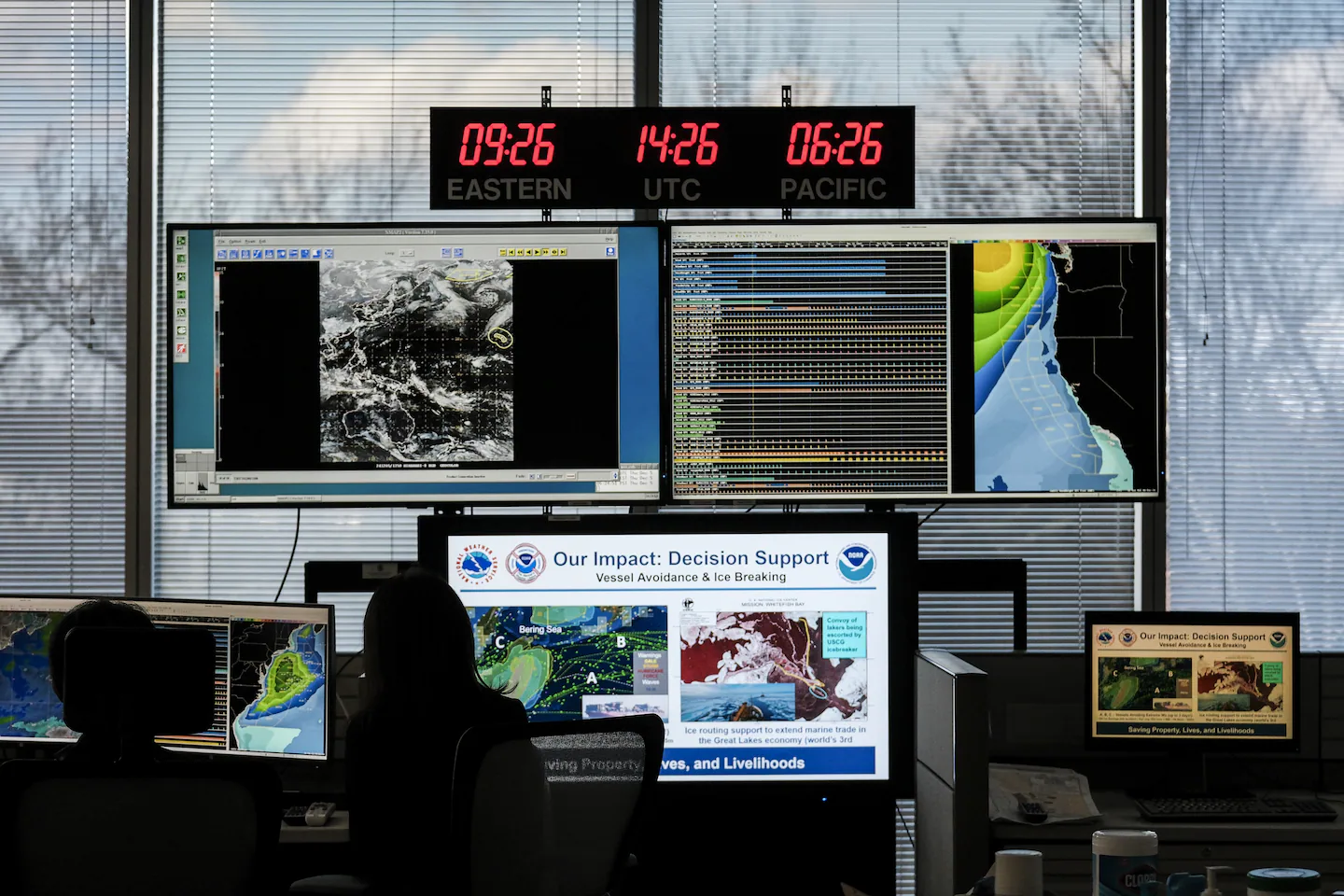
So far, exhausted employees have maintained weather monitoring and forecasting almost without interruption, staff said. But many are wondering how much longer they can keep it up. If the government shuts down next week when funding runs out, many employees could also find themselves working without pay, at least temporarily.
“We have a strained and severely stretched situation,” said Tom Fahy, legislative director for the National Weather Service Employees Organization, the union that represents the agency’s workers. The Weather Service has a famously dedicated workforce, he said, but workers can put in only so many long hours and extra shifts. “There’s a breaking point.”
Fahy said two offices — one in California’s Central Valley and another in western Kansas — no longer have enough staffing to operate around the clock. And, he added, “there are still a dozen offices across the country that are operating on reduced staffs.”
John Sokich, who worked for the Weather Service for 45 years before retiring in January, said the agency is “unfortunately, incredibly adept” at keeping its forecasts and warnings going in strained circumstances. Still, he compared the Weather Service these days to a sprinter forced to extend an all-out race from 200 yards to a mile.
“They’re going to run out of gas,” Sokich said. “They’re going to start missing things. They can’t sustain that level of effort for much longer. You just can’t sprint a mile.”
Asked about staffing concerns within the Weather Service, spokeswoman Erica Grow Cei wrote in a statement that the agency “is carefully evaluating the need for additional personnel and posting jobs to fill positions deemed necessary for operational continuity. These jobs are being offered as needed to ensure both the safety of Americans and the responsible use of taxpayer dollars.” The White House did not respond to a request for comment.
An NOAA spokesperson wrote in a separate emailed statement that the Weather Service “remains equipped to meet its mission of protecting American lives and property through timely forecasts and critical decision support services.” The spokesperson cited the agency’s performance during the catastrophic Texas floods as evidence it has “maintained its operational excellence despite alarmist allegations.”
The agency began the year by losing nearly 100 probationary employees — workers with fewer years of service and lesser job protections — to the Trump administration’s mass firings of such staffers. Over the next several months, roughly 500 more employees opted to take buyouts, retire or resign, Fahy said, taking advantage of opportunities offered as part of President Donald Trump’s campaign to slim down the government.
Even before this year’s losses, the Weather Service was considered understaffed, employing roughly 4,300 people — 200 below ideal personnel levels, agency leaders said at the time. But the sudden cuts were unprecedented in the agency’s recent history, Fahy said. Between 2010 and 2015, for example, roughly 600 workers left the Weather Service through attrition and retirement — this year, the same number vanished in a matter of months.
“In my time here, the agency has never, ever been below 4,000,” said Brian LaMarre, who worked for the Weather Service for more than three decades before taking a position as chief meteorologist with Inspire Weather. “This is uncharted waters.”
As a result, some local forecasting offices lost the ability to operate 24/7, cut back on launching weather balloons or staggered shifts ahead of extreme weather. Over the summer, the Weather Service grew so concerned about diminished forecasting teams that the agency offered to cover moving expenses for any workers willing to transfer to hard-hit offices in coastal Texas and Louisiana, among other places.
Now, midway through a hurricane season that forecasters initially expected to bring as many as 19 named storms, staff are finding ways to keep things running, they said — often at significant cost to their work-life balance and physical and mental health. Managers are picking up forecasting shifts. In a bid to ensure robust forecasting, some offices are sharing their employees remotely with understaffed locations, at times requiring those staffers to work overtime or through weekends.
The situation in one eastern U.S. office is typical, said an employee there, who spoke on the condition of anonymity for fear of losing his job. His office is down nearly half a dozen meteorologists and has been for months, he said, meaning everyone has had to work a lot harder, for longer, to ensure forecasting remains uninterrupted. To reduce the burden on remaining employees, the office switched to requiring only one staffer on each overnight shift, instead of two.
Even so, everyone must take midnight shifts far more often than they used to, the employee said. Staff must also coordinate their vacations so they don’t overlap. And any sudden illness probably means someone has to work a surprise double shift, because “there’s no wiggle room anymore,” the employee said.
“People are burning out,” the employee said. “Just in conversations, you can tell everyone is starting to get a little frayed.”
Many offices have ceased launching weather balloons, a vital tool for forecasting, to save time and personnel. And across the country, current and former Weather Service staff said, offices are forgoing their normal outreach and training initiatives for local residents to prioritize the forecast above all else.
Cutting community initiatives could have negative effects down the line, warned Sokich, the recent Weather Service retiree, because Weather Service staff use those sessions to explain when, why and how to respond to severe weather.
Without this communication, “education is not reaching emergency managers who will need to coordinate with the NWS to, for example, evacuate people,” Sokich said. “That will mean there’s no relationship with them, no coordination. They’ll be running blind during weather events.”
The Trump administration’s announcement last month that the Weather Service could list and hire 450 positions was hailed inside and outside the agency as a positive sign. But it won’t be an immediate fix.
Finding and onboarding new forecasters will take significant time, said Jeff Masters, a meteorologist who writes on climate change and weather for Yale Climate Connections and for years served with NOAA’s Hurricane Hunters. Bound by a web of rules and laws, federal hiring is often slow, he said. And it’s an open question how many people will want to apply — government work may seem like a bad option, since Trump has stripped away the guaranteed job stability that once made up for the lower pay. Moreover, the Weather Service is in the midst of significant change, as the Trump administration aims to eliminate funding for anything tied to climate change.
On top of that, Masters said, Weather Service job applications are slated to include questions about what potential forecasters would do to further Trump’s policy goals. This change is part of Trump’s broader overhaul of government hiring, meant to transform the nonpartisan, merit-based workforce into one that rewards loyalty to the president.
“You’re going to discourage qualified employees from applying because of these questions that have nothing to do with how well you can make a forecast, or if you are able to put out a proper weather warning,” Masters said. “It’s not relevant to the job.”
It may ultimately be impossible to replace what’s been lost, at least in the short term, said Chris Vagasky, research program manager for Wisconet, a statewide network of weather and soil monitoring stations based at the University of Wisconsin. Staffers representing decades of expertise and institutional knowledge headed for the exits, he said. Anyone coming in now will certainly be far less experienced.
“We are patching something that we damaged,” he said of the hiring efforts. “It’s putting a Band-Aid on a major wound.”



